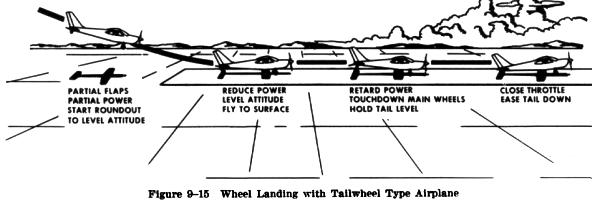
Power on approaches at an airspeed slightly above the normal approach speed should be used for landing in significantly turbulent air. This provides for more positive control of the airplane when strong horizontal wind gusts, or up and down drafts, are experienced.
Like other power on approaches (when the pilot can vary the amount of power), the angle of descent is controlled primarily by pitch adjustments, and the airspeed controlled primarily by changes in power. Nevertheless, a coordinated combination of both pitch and power adjustments is usually required. As in most other landing approaches, the proper approach attitude and airspeed require a minimum roundout or flare and should result in little or no floating during the landing.
To maintain good control, the approach in turbulent air with gusty crosswind may require the use of partial wing flaps. With less than full flaps, the airplane will be in a higher nose up attitude. Thus, it will require less of a pitch change to establish the landing attitude, and the touchdown will be at a higher airspeed to ensure more positive control. However, the speed should not be so excessive that the airplane will "float" past the desired landing area.
These landing approaches are usually performed at the normal approach speed plus one-half of the wind gust factor. If the normal speed is 70 knots and the wind gusts increase 15 knots, an airspeed of 77 knots is appropriate. In any case, the airspeed and the amount of flaps should be as the airplane manufacturer recommends.
An adequate amount of power should be used to maintain the proper airspeed throughout the approach, and the throttle retarded to idling position only after the main wheels contact the landing surface. Care must be exercised, however, in closing the throttle before the pilot is ready for touchdown, as in this situation the sudden or premature closing of the throttle may cause a sudden increase in the descent rate which could result in a hard landing.
Landings from power approaches in severe turbulence should be such that touchdown is made with the airplane in approximately level flight attitude. In nosewheel type airplanes, the nose up pitch attitude at touchdown should be only enough to prevent the nosewheel from contacting the surface before the main wheels have touched.

In tailwheel type airplanes, touchdown should be made smoothly on the main wheels, with the tailwheel held well clear of the runway (Fig. 9-15). This is called a "wheel landing " and requires very careful timing and control usage to prevent bouncing. These wheel landings can be best accomplished by holding the airplane in level flight attitude until the main wheels touch, then immediately but smoothly retarding the throttle, and holding sufficient forward elevator pressure to hold the main wheels on the ground. The airplane should never be forced onto the ground by excessive forward pressure.
If the touchdown is made at too high a rate of descent as the main wheels strike the landing surface, the tail is forced down by its own weight. In turn, when the tail is forced down, the wing's angle of attack increases resulting in a sudden increase in lift and the airplane may become airborne again. Then as the airplane's speed continues to decrease, the tail may again lower onto the runway. If the tail is allowed to settle too quickly, the airplane may again become airborne. This process, often called "porpoising," usually intensifies even though the pilot tries to stop it. The best corrective action is to reject the landing and execute a go-around procedure.